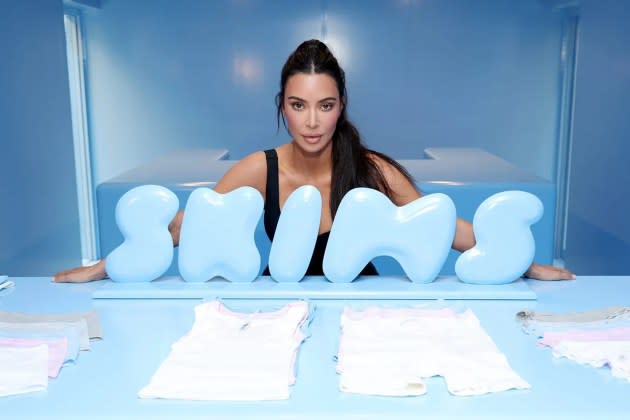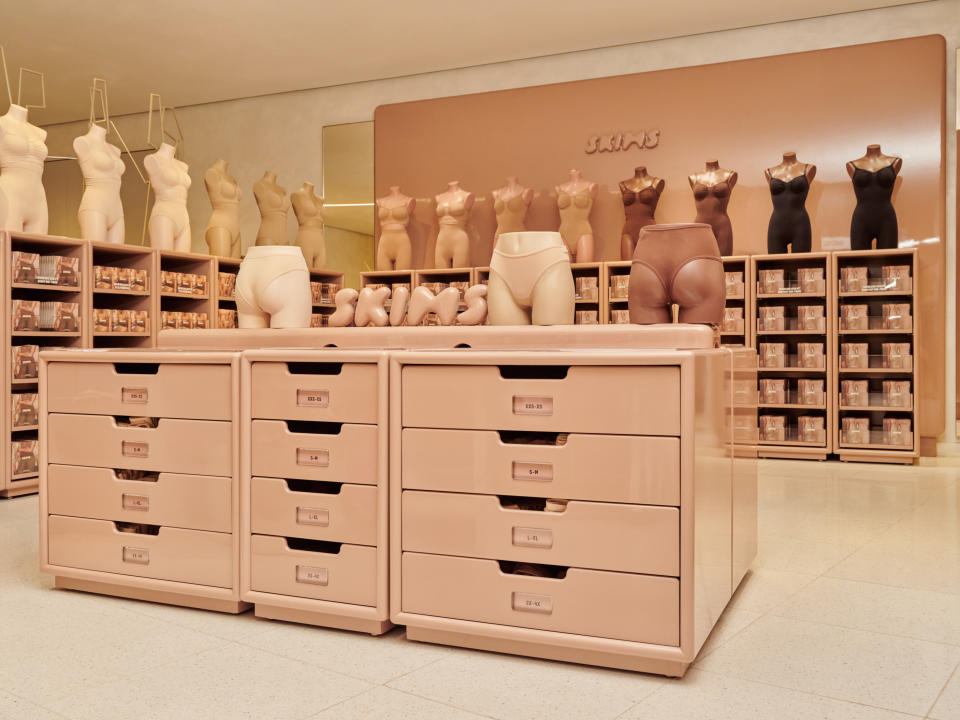How Kim Kardashian’s Skims Could Wake Up Wall Street


Wall Street and fashion might just need a little more Kim Kardashian.
That sounds preposterous, of course.
More from WWD
EXCLUSIVE: Club Monaco Is Going Back to 'Great, Simple,' Quality Roots
How Tommy Hilfiger Has Kept the Momentum Going for Nearly 40 Years: A History and Timeline
Why with the 24/7, always-on world of social media knocking down the door would anyone actually need more of the mega influencer?
Nonetheless, there it is.
Kardashian, who over her career has managed to be in the right place more often than not, finds herself there again and in a couple of ways.
The market for IPOs, for one, is feeling a little blah for fashion. There are companies teasing offerings or weighing their options, the Golden Gooses and the Vuoris of the world among them. And there is the mammoth Shein that has seen its valuation reportedly yo-yo from $100 billion to $45 billion as it looks for a home and struggles with the political complications of its Chinese roots.
Birkenstock was the big hope of the IPO market last year, but the offering was overly ambitious and unluckily timed, coming right after the outbreak of war in Israel and Gaza. The 250-year-old sandal-maker is on firmer ground in the stock market now, trading modestly above its $46 offering price, but the IPO missed its mark.
Even though the market is soaring, with the Dow Jones Industrial Average hitting new highs last month, there doesn’t seem to be an onramp for new offerings.
Bill Smith, cofounder and chief executive officer of IPO specialist Renaissance Capital, said in recent analysis: “The stock market is firing on all cylinders and yet the IPO calendar is empty….Not many IPOs want to be first. Despite the rally in tech stocks, IPO investors have been cautious around pricing, and want bigger discounts until they see a consistent stream of winners. Many companies can afford to wait for others to be the guinea pigs.”
One company needs to come out and show it’s possible and stage an offering that not just makes money for the early backers, but can hit the ground running and pave the way for others.
For fashion, at least, that company could be Skims.
Already the Kardshian-fronted brand raised $270 million from institutional backers last July, snagging a $4 billion valuation and setting the company up for an offering.
It’s a business that not only meets many of the fashion industry’s modern aspirations, but also the demands of Wall Street.
Kardashian is not just famous, but famous enough to build a successful brand starting in the very functional world of shapewear. Her Instagram following of 364 million exceeds the U.S. population by 32 million.
And she — along with her partners Emma and Jens Grede — has built a brand that represents an inclusive vision of beauty, from body shape to skin tone. It’s said to be growing quickly, with sales as of last summer seen growing to $750 million from $500 million in 2022. And Skims is said to be making oodles of money along the way, although it won’t be clear just how much money until the company actually files for an offering.
Big digital reach, profitable growth and an inclusive approach — it’s a narrative Wall Street can get behind.
A profitable and growing business would also bring Wall Street back to one of its favorite themes. The post-pandemic rush of IPOs from the likes of Allbirds and Rent the Runway Inc. did little good to anybody as coming to market with growth, but no profits, led to a series of stock market face-plants.

Fashion could also use something new, a business model that is really working well that can be studied and tested and, maybe, replicated elsewhere.
The industry is a little tired.
Stalwarts of yesteryear are hanging on, trying to reinvent. Some are succeeding. Ralph Lauren Corp. kicked its unhealthy outlet habit, PVH Corp. is giving a new spin to Calvin Klein and Tommy Hilfiger.
Still, there are plenty of businesses still struggling to make their way, like Macy’s Inc., the department store superforce that is fending off an activist takeover and plans to close 150 stores, trimming its namesake chain down to 350 stores.
And there are plenty more that have faded from the market over the years, from the once-stalwart Liz Claiborne Inc. that dressed a generation of women for work to Farfetch that promised to log in the whole luxury world only to fall apart.
There are plenty of questions important to the future of Skims. How far can the brand reach out beyond its base? How sustainable are its profits? How much does the brand rely on Kardashian herself? How will the company take the heat of being a public company? And so on.
But Kardashian’s success has drawn attention, just like the success of Rihanna’s Fenty hasn’t gone unnoticed in beauty. (Although her efforts to build a luxury brand with the banking of LVMH Mo?t Hennessy Louis Vuitton failed to catch fire, proving even celebrities have their limits.)
They both have online reaches that are pretty much impossible to be replicated, but there are plenty of celebrities mulling around fashion.
If a few more of them are able to move their lines beyond vanity projects and build big businesses, an interesting new theme will be strengthened.
And that will in turn push everybody else all the harder, helping the fashion industry inch toward its next iteration. This is how it happens, brands, designers and CEOs chase the restless spirit of the consumer — catch it, lose it, catch it again and fashion moves a step forward.
The runways in New York, Milan and Paris tell an important part of fashion’s story of change. Much of the rest of the tale can be found on the ticker tape, or well, the nearest screen flashing stock market updates.
The Bottom Line is a business analysis column written by Evan Clark, deputy managing editor, who has covered the fashion industry since 2000. It appears every other Thursday.
Best of WWD
